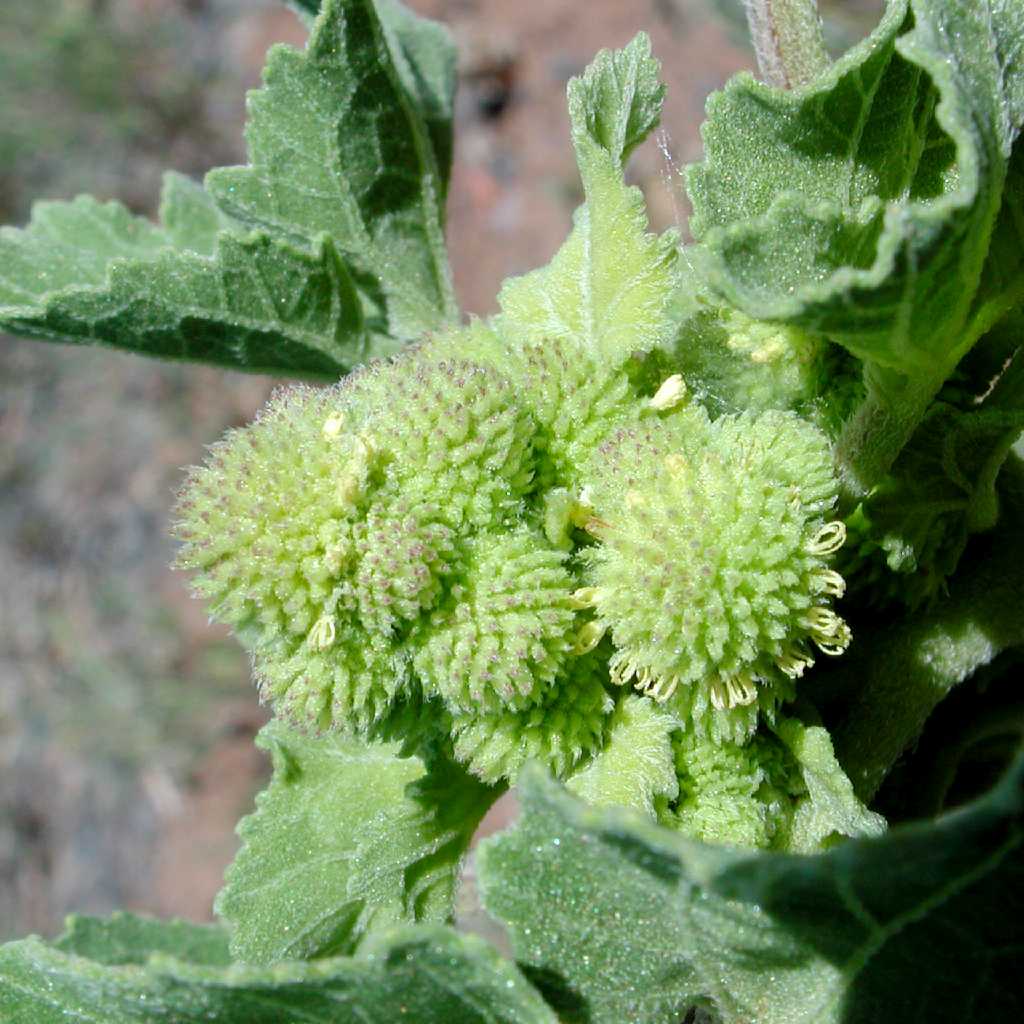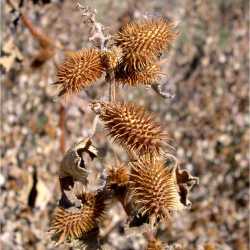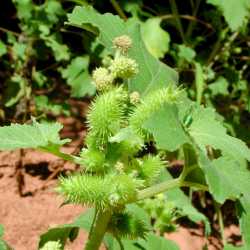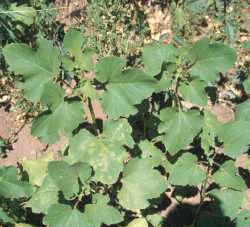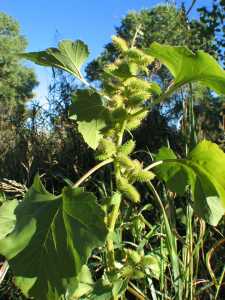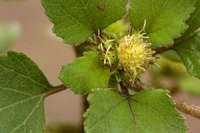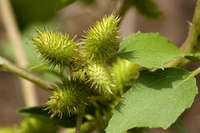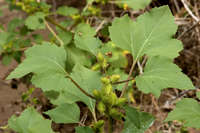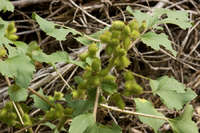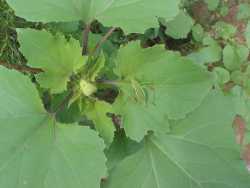|
|
|
|
Family: Asteraceae
rough cocklebur
|
Plants 10-80(-200) cm; nodal spines 0. Leaves: petioles 20-100(-140+) mm; blades suborbiculate to ± pentagonal or deltate, 4-12(-18+) × 3-10(-18+) cm, sometimes palmately 3-5-lobed, abaxial faces green, hirtellous. Burs 10-30+ mm. 2n = 36. Flowering Jul-Oct. Damp or seasonally wet, often alkaline, soils, waste places, margins of agriculture; 10-2000 m; Alta., B.C., Man., N.B., N.S., Ont., P.E.I., Que., Sask.; Ala., Alaska, Ariz., Ark., Calif., Colo., Conn., Del., D.C., Fla., Ga., Idaho, Ill., Ind., Iowa, Kans., Ky., La., Maine, Md., Mass., Mich., Minn., Miss., Mo., Mont., Nebr., Nev., N.H., N.J., N.Mex., N.Y., N.C., N.Dak., Ohio, Okla., Oreg., Pa., R.I., S.C., S.Dak., Tenn., Tex., Utah, Vt., Va., Wash., W.Va., Wis., Wyo.; Mexico; Central America; South America; widely introduced in Old World. Recognition of a dozen or more taxa (treated as species, subspecies, varieties, and/or forms) has been proposed for plants treated together here as Xanthium strumarium. Bases for the various taxa mostly involved subtle differences in the burs.
Plants 2-20 dm, appressed-hairy or subglabrous; lvs long-petiolate, broadly ovate to suborbicular or reniform, generally cordate or subcordate at base, sometimes shallowly 3-5-lobed, often 15 cm; staminate heads in a terminal cluster, the pistillate ones in several or many short axillary infls; bur broadly cylindric to ovoid or subglobose, 1-3.5 cm, covered with stout hooked prickles, terminated by 2 straight or in ours ±incurved beaks; 2n=36. Fields, waste places, flood-plains, and lake- and sea-beaches; now a cosmopolitan weed, probably originally native only to the New World. July-Sept. Our most common phase is var. canadense (Mill.) Torr. & A. Gray, with the burs brownish or yellowish-brownish, 2-3.5 cm, the lower part of the prickles conspicuously spreading-hairy as well as ±stipitate-glandular. (X. echinatum; X. italicum; X. pensylvanicum; X. speciosum) Also found throughout our range is var. glabratum (DC.) Cronquist, with merely atomiferous- glandular or glandular-puberulent to subglabrous, commonly paler burs seldom over ca 2 cm. (X. americanum; X. chinense; X. cylindraceum; X. echinellum; X. globosum; X. inflexum) Var. strumarium, with straight-beaked, yellow-green, merely puberulent burs to 2 cm, occurs in tropical Amer. and in s. Europe, and rarely in our range as a waif. Gleason, Henry A. & Cronquist, Arthur J. 1991. Manual of vascular plants of northeastern United States and adjacent Canada. lxxv + 910 pp. ©The New York Botanical Garden. All rights reserved. Used by permission. FNA 2006, Wiggins 1964, Kearney and Peebles 1969, Heil et al. 2013 Duration: Annual Nativity: Native Lifeform: Forb/Herb General: Annual herbs, 20-80 cm tall (occasionally up to 2 m tall); stems erect, appressed-hairy or sub-glabrous. Leaves: Alternate along the stems, on long petioles; blades broad, sub-orbicular to deltate (triangular), 4-18 cm long, 3-18 cm wide, toothed and sometimes shallowly 3- 5-lobed, the surfaces rough-hairy. Flowers: Flower heads inconspicuous, in sessile axillary clusters. Fruits: Burs brownish or yellowish-brownish, subglobose to ellipsoid, mostly 2-4 cm long, terminated by two stout, incurved beaks, and covered with stout, hooked prickles. Ecology: Found in moist, disturbed areas including fields, waste places, floodplains and lake beaches, below 7,500 ft (2286 m); flowers April-October. Distribution: Native to the New World and widespread throughout the US and CAN; south through MEX, C. Amer., to the tip of S. America; widely introduced in the Old World. Notes: Easily distinguished by its large fruits that are burs with long hooked bristles. The leaves sand-papery to the touch, and the flowers resemble those of ragweed (Ambrosia spp.) Many subspecies and varieties have been proposed based on burr morphology, but FNA does not formally recognize any of them. Burrs become entangled in animal hides and hikers' socks, promoting the dispersal of the seeds. Seeds and cotyledon leaves are poisonous to livestock, while morning doves eat the seeds. Ethnobotany: The leaves made into a tea make a useful diuretic, but in large quantities it can have toxic effects. The plant can be used to make a yellow dye. Etymology: Xanthos is Greek for yellow, referring to the yellow dye made from the leaves; strumarium comes from the Latin struma, or tumor, possibly referring to the burrs. Synonyms: Xanthium strumarium var. strumarium, Xanthium acerosum, Xanthium californicum, Xanthium californicum var. rotundifolium, Xanthium campestre, Xanthium canadense, Xanthium cavanillesii, Xanthium cenchroides, Xanthium commune, Xanthium echinatum, Xanthium gl Editor: SBuckley 2010, FSCoburn 2015, AHazelton 2017 |
|
|
|


